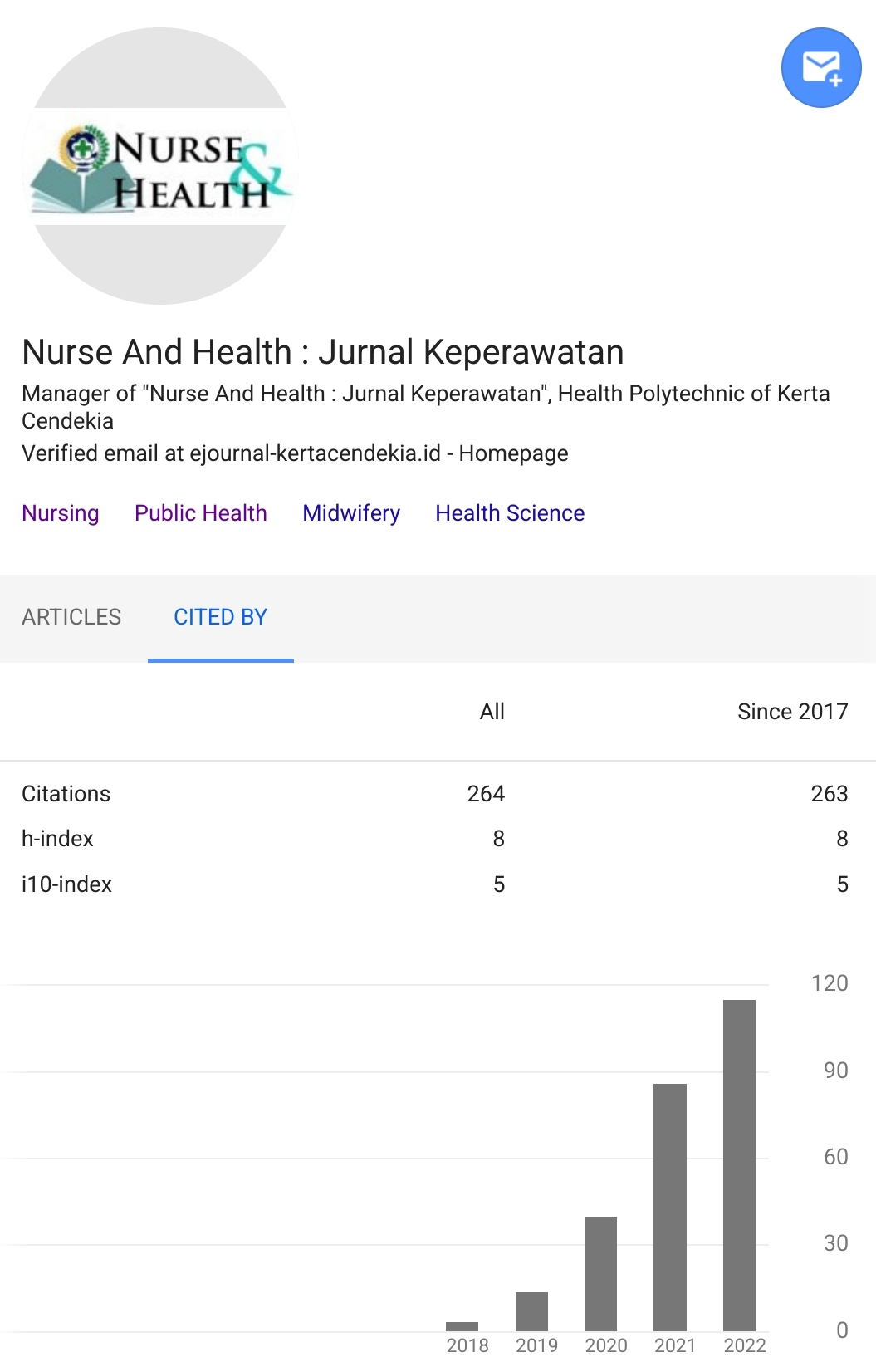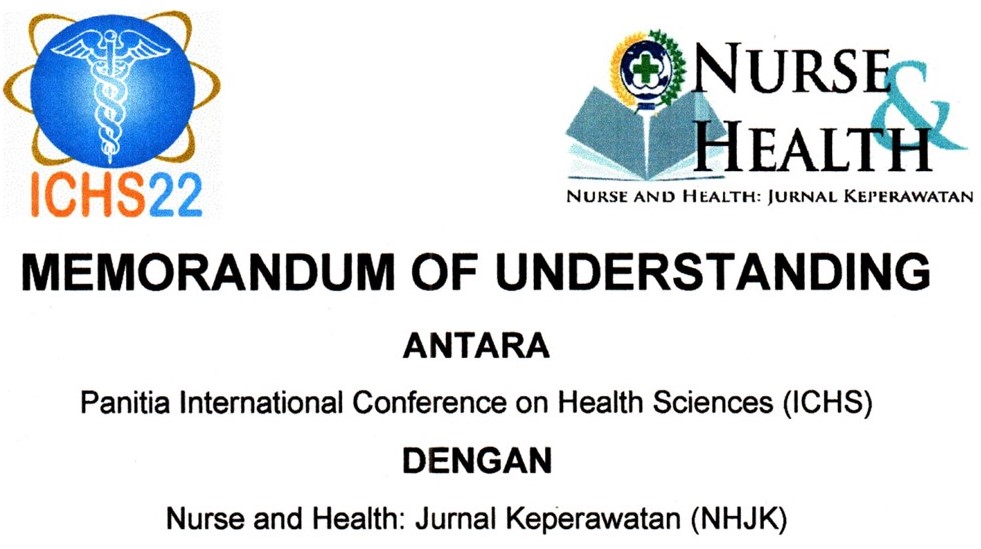CORRELATION BETWEEN ANXIETY AND BREAST MILK PRODUCTION AMONG BREASTFEEDING MOTHERS IN PUBLIC HEALTH CENTER OF JAGIR, SURABAYA
Abstract
Background: The low coverage of exclusive breastfeeding in Indonesia is caused by several factors, one of which is anxiety. The mother feels anxious because she is unable to provide enough milk for her baby.Objectives: The purpose of this study is to analyze the correlation between anxiety and breast milk production among breastfeeding mother in Public Health Center of Jagir, Surabaya.Methods: The design of this study was observational analytic with the cross-sectional approach. The study population were all of breastfeeding mothers in Public Health Center of Jagir, Surabaya who met the inclusion and exclusion criteria. The sample of this study was recruited through purposive sampling as many as 67 mothers. Data were collected by using the State Anxiety Inventory Questionnaire and the breast milk production observational sheet. The results of Cronbach Alpha test for the State Anxiety Inventory Questionnaire was .619 and the breast milk production observational sheet was .711. Descriptive statistics and Spearmen Rank Test with significance value less than .05 were used to analyzed data.Results: The results showed: 1) most breastfeeding mothers experienced moderate anxiety (91.04%), 2) some breastfeeding mothers showed smooth milk production (61.19%), 3) There was a correlation between anxiety and breast production in breastfeeding mothers (p = 0.001).Conclusion: The more severe anxiety in nursing mothers, the production of breast milk becomes not smooth. Future studies are expected to analyze other factors that can affect breast milk production in breastfeeding mothers. Keywords: Anxiety, Breast Milk Production, Breastfeeding MotherDownloads
References
Budiarti, T. (2009). EFEKTIFITAS PEMBERIAN PAKET ”SUKSES ASI” TERHADAP PRODUKSI ASI IBU MENYUSUI DENGAN SEKSIO SESAREA DI WILAYAH DEPOK JAWA BARAT. Thesis Post Graduate Program, Faculty of Nursing, Universitas Indonesia, 1–128.
Christian, L. M. (2012). Psychoneuroimmunology in pregnancy: Immune pathways linking stress with maternal health, adverse birth outcomes, and fetal development. Neuroscience and Biobehavioral Reviews, 36(1), 350–361. https://doi.org/10.1016/j.neubiorev.2011.07.005
Dewi, U. M., & Windarti, Y. (2017). Efektivitas Pompa Air Susu Ibu : Studi Kasus pada Ibu Bekerja ( Effectiveness of Breastfeed Pumps : Case Study on Working Mothers ). (57), 42–46.
Flaherman, V. J., Beiler, J. S., Cabana, M. D., & Paul, I. M. (2016). Relationship of newborn weight loss to milk supply concern and anxiety: the impact on breastfeeding duration. Maternal and Child Nutrition, 12(3), 463–472. https://doi.org/10.1111/mcn.12171
Kamariyah, N. (2014). Kondisi Psikologi Mempengaruhi Produksi ASI Ibu Menyusui di BPS Aski Pakis Sido Kumpul Surabaya. Jurnal Ilmiah Kesehatan, 7(12), 29–36.
Kemenkes. (2014). Infodatin ASI: Situasi dan Analisis ASI Eksklusif. Jakarta: Kementerian Kesehatan Republik Indonesia.
Mardjun, Z., Korompis, G., & Rompas, S. (2019). Hubungan Kecemasan Dengan Kelancaran Pengeluaran Asi Pada Ibu Post Partum Selama Dirawat Di Rumah Sakit Ibu Dan Anak Kasih Ibu Manado. E-Journal Keperawatan, 7(1).
Nugraheni, D. E., & Kosma, H. (2017). Metode SPEOS (Stimulasi Pijat Endorphin, Oksitosin dan Sugestif) dapat Meningkatkan Produksi ASI dan Peningkatan Berat Badan Bayi. Jurnal Kesehatan, 8(1), 1–7. Retrieved from https://ejurnal.poltekkes-tjk.ac.id/index.php/JK/article/view/384/359
Nurliawati, E. (2010). Faktor-Faktor Yang Berhubungan Dengan Produksi Air Susu Ibu Pada Ibu Pasca Seksio Sesarea Di Wilayah Kota Dan Kabupaten Tasikmalaya. Thesis Post Graduate Program, Faculty of Nursing, Universitas Indonesia. Retrieved from http://lib.ui.ac.id/file?file=digital/20282685-T Enok Nurliawati.pdf
Puspitosari, W. A., & Prasetya, A. B. (2007). Perbandingan Tingkat Kecemasan Ibu Menyusui Bekerja dan Tidak Bekerja. Mutiara Medika, 7(2), 77–81.
Sari, L. P., Salimo, H., & Budihastuti, U. R. (2017). Optimizing the Combination of Oxytocin Massage and Hypnobreastfeeding for Breast Milk Production among Post-Partum Mothers. Journal of Maternal and Child Health, 02(01), 20–29. https://doi.org/10.26911/thejmch.2017.02.01.03
Spielberger, C. D., Gorsuch, R. L., Lushene, R., Vagg, P. R., & Jacobs, G. A. (1983). State-Trait Anxiety Inventory for adults (Form Y). 0–75.
Widayanti, W. (2014). Efektivitas Metode “Speos” (Stimulasi Pijat Endorphin, Oksitosin Dan Sugestif) Terhadap Pengeluaran Asi Pada Ibu Nifas. 14–68.
Authors who publish with Nurse and Health: Jurnal Keperawatan agree to the following terms:
- Authors retain copyright licensed under a Creative Commons Attribution-NonCommercial 4.0 (CC BY-NC 4.0), which allows others to remix, tweak, and build upon the authors' work non-commercially, and although the others' new works must also acknowledge the authors and be non-commercial, they don't have to license their derivative works on the same terms.
- Authors are permitted and encouraged to post their work online (e.g., in institutional repositories or on their website) prior to and during the submission process, as it can lead to productive exchanges, as well as earlier and greater citation of published work (See The Effect of Open Access). Authors can archive pre-print and post-print or publisher's version/PDF.








_resize1.jpg)















